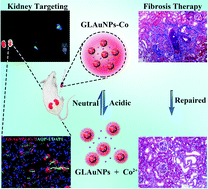A stimuli-responsive drug release nanoplatform for kidney-specific anti-fibrosis treatment†
Abstract
The renoprotective effects of hypoxia inducible-factor (HIF) activators have been demonstrated by improving renal hypoxia in chronic kidney disease. Cobalt chloride is one of the most widely used HIF activators in biomedicine; however, poor kidney targeting and undesirable side effects greatly limit its clinical applications. Here, we report a novel stimuli-responsive drug release nanoplatform in which glutathione (GSH)-modified Au nanoparticles (GLAuNPs) and Co2+ self-assemble into nanoassemblies (GLAuNPs-Co) through coordination interactions between empty orbitals of Co2+ and lone pairs of GSH. The GLAuNPs, when used as a drug carrier, demonstrated high drug loading capacity and pH-triggered drug release after assembling with Co2+. The acidic environment of lysosomes in renal fibrosis tissues could disassemble GLAuNPs-Co and release Co2+. Moreover, encapsulation of the Co2+ ions in the GLAuNPs greatly lowered the cytotoxicity of Co2+ in kidney tubule cells. Tissue fluorescence imaging showed that GLAuNPs-Co specifically accumulated in the kidneys, especially in the renal proximal tubules. After GLAuNPs-Co was intraperitoneally injected into ureter-obstructed mice, significant attenuation of interstitial fibrosis was exhibited. The beneficial effects can be mainly ascribed to miR-29c expression restored by HIF-α activation. These findings revealed that GLAuNPs-Co have pH-responsive drug release and renal targeting capabilities; thus, they are a promising drug delivery platform for treating kidney disease.



 Please wait while we load your content...
Please wait while we load your content...